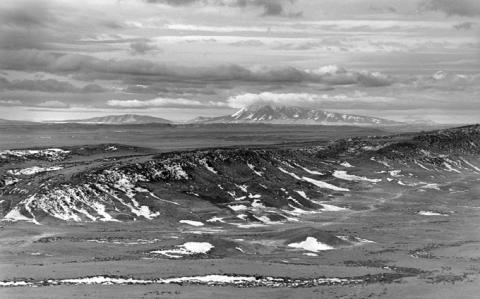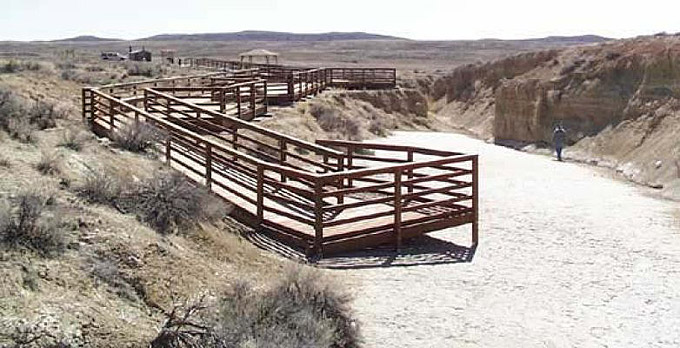- Home
- Encyclopedia
- Wyoming’s Dinosaurs (and One Columbian Mammoth)
Wyoming’s Dinosaurs (and one Columbian Mammoth)
Wyoming's fossils have been important to science since the 1870s and continue to be useful today. Remains of Triceratops, Diplodocus, Tyrannosaurus and others have helped answer—and raise—many questions about the ancient history of the planet and have captured popular imagination with their size or fierce appearance. The scientific value of these fossils and the public interest in them has brought many different collectors to the state who excavate fossils for shipment to museums all over the country. However, only a few major finds from Wyoming have remained in the state.

In 1877, employees of the Union Pacific Railroad found large bones weathering out of the hills at Como Bluff near Medicine Bow, Wyo., and wrote to paleontologist Othniel C. Marsh of Yale College, in Connecticut. Within a year, diggers hired by Marsh and teams working for paleontologist Edward D. Cope, of Philadelphia were excavating tons of fossil bones for shipment east. Marsh and Cope were bitter professional rivals, and the same spirit infected their employees.
Diggers smashed bones in the quarries of the other teams and even in their own to avoid thefts. No one will ever know what valuable specimens were lost to this rivalry, but the ones which were gained include Dryolestes, the first Jurassic mammal discovered in North America; large pieces of Apatosaurus, then known as Brontosaurus; several Baptanodons—marine reptiles; and many others. Specimens collected for Marsh went to the Peabody Museum at Yale; those gathered for Cope went mostly to the Academy of Natural Sciences in Philadelphia.
Museums closer to the fossil locations also acquired specimens. In the 1890s, the University of Wyoming accumulated a large collection of Jurassic fossils (unfortunately, most of this collection was lost to flooding in the 1920s), and in 1895 Prof. Samuel Williston of the University of Kansas traveled to Lusk, Wyo., to collect for the university’s museum the first Triceratops skull ever to go on display.
The best and most scientifically important fossils, however, left the region in large part because the expert collectors, the most eminent scientists and the best museum facilities—where specimens could be safely preserved for future examination by scientists—were on the East Coast.
In 1898, the American Museum of Natural History discovered the Bone Cabin Quarry north of Medicine Bow, where fossil bones were so plentiful that a local resident built his cabin’s foundation entirely with bone chunks. (This structure no longer exists, and is a different structure from the so-called fossil cabin, a roadside attraction on U.S. 30 just south of Como Bluff built entirely of fossil bones in the 1930s.)
In the five years following 1898, the Bone Cabin Quarry was worked nearly to exhaustion, yielding parts of many large Jurassic dinosaurs in the process. Additionally, AMNH crews explored other areas of the state, discovering a duck-billed dinosaur of the hadrosaur family near Lusk that retained extensive skin impressions surrounding the body.
On July 2, 1899, a Diplodocus was found at Sheep Creek about 25 miles north of Como Bluff. This fossil was one of the first large specimens collected for the budding Carnegie Museum of Pittsburgh, Pa. When Andrew Carnegie paid to have the skeleton replicated and copies sent to museums in Britain, Europe and Argentina, he made it perhaps the most famous dinosaur ever to come from Wyoming. Millions of people first heard of dinosaurs and paleontology by seeing a mount of Diplodocus carnegii.
A second dinosaur from the Sheep Creek quarry was an Apatosaurus excavated in 1901. It also was dug for the Carnegie Museum, but never mounted. In 1955, the University of Wyoming in Laramie, Wyo. acquired this specimen for its Geological museum, where it is still on display.
In 1975, numerous tracks of pterosaurs—flying reptiles—were discovered near Alcova Lake. At that time, only one set of tracks was known; with the evidence provided by the Alcova fossils, some long‑standing assumptions about the behavior and environment of pterosaurs were revised.
In 1991, a private collector found an Allosaurus near Shell, Wyo., on the west flank of the Bighorn Mountains. The fossil was eventually determined to lie on public land and was collected by the Bureau of Land Management, the Museum of the Rockies in Bozeman, Mont., and the University of Wyoming. The Museum of the Rockies retained the bones and made casts, now on display in Bozeman and Laramie. This discovery of "Big Al" and associated fossils helped prompt an effort to revise fossil law and limit commercial collecting on public land.

In 1997, the Red Gulch Dinosaur Tracksite, the largest in Wyoming, was discovered in the Sundance Formation southwest of Shell, the tracks apparently representing a large herd of dinosaurs moving along a beach. Scientists had previously thought that the entire Sundance Formation was marine—that is, that its sediments were laid down under water—but these tracks showed that a large dry area must have been present to support such numbers of land dwellers.
In 2006, "Apollo," one of the most complete diplodocid skeletons, retaining 83 percent of the original bones, was dug at Tensleep, Wyo., by a private firm. This specimen was discovered with others in a world‑class assemblage of numerous nearly complete skeletons, and the new material is already stirring debates over the habits and relationships of sauropods, the long-tailed, long-necked, elephant-legged plant eaters, including Diplodocus, Apatosaurus and Superasaurus.
In recent years, museums in Wyoming, such as the private Wyoming Dinosaur Center of Thermopolis and the Tate Museum of Casper College, have been expanding and acquiring more, more complete and more intact specimens. "Jimbo," the Supersaurus vivianae at the Dinosaur Center, was discovered near Douglas in 1995 and, as the second specimen of one of the biggest sauropod species known, has been exhibited internationally. Current research on this fossil may help scientists reclassify the sauropod family.
"Dee," the largest mounted Columbian mammoth in North America, was found in 2006 on a ranch north of Casper, Wyo. and is now on display at the Tate Museum. The Tate has also recently collected a Tyrannosaurus rex north of Lusk, Wyo.; this specimen is the first found in Wyoming to stay in the state.
Wyoming's fossils have contributed to cultural and scientific development across much of the world and will probably continue to do so. Although the supply of world-class specimens is limited, it is not yet exhausted. Many in Wyoming hope that as its scientific institutions mature, the state will be able and qualified to retain some of these finds.
Resources
- "Apollo, the most complete Diplodocus ever discovered…" Accessed 9/3/11 at www.washakiemuseum.org/doc/apollo_til_Oct1.pdf
- Bennette, S. Christopher. "Terrestrial Locomotion of Pterosaurs: a Reconstruction Based on Pteraichnus Trackways." Journal of Vertebrate Paleontology 17, no. 1, (1997): 104-113.
- "Casper College Announces Discovery of T. Rex." Casper College News Release, February 23, 2011. Accessed 9/3/2011 at www.tatetrex.com/press/downloads/DiscoveryAnnouncement-0211.doc
- Colbert, Edwin. The Great Dinosaur Hunters and Their Discoveries. New York: E. P. Dutton and Co, 1968, 151-154, 195-196.
- "Dee the Mammoth and the Pleistocene Exhibit." Accessed 9/3/2011 at www.caspercollege.edu/tate
- "Discovery/Background" [of the Red Gulch Dinosaur Tracksite] Accessed 9/3/2011 at http://www.blm.gov/wy/st/en/field_offices/Worland/Tracksite/discovery.html
- "Discovery of Rare Fossil in Wyoming Sparks Protection Bill for Dinosaur Bones and Fish," The Sheridan Press, 11 July 1992, 13.
- Galliano, Henry and Raimund Albersdorfer, “A New Basal Diplodocid Species …” Tensleep, Wyo.: Dinosauria International, 2010. Accessed Aug. 29, 2010 at http://dinosauriainternational.com/downloads/Amphicoelias.pdf.
- "Jimbo the Supersaurus." Casper Star-Tribune, 4 June 2007.
- Kohl, Michael, Larry Martin and Paul Brinkman, eds. A Triceratops Hunt in Pioneer Wyoming. Glendo, Wyo.: High Plains Press, 2004, 14-24.
- Logue, Terrence. "Preliminary Investigation of Pterodactyl Tracks at Alcova, Wyoming." The Wyoming Geological Association Earth Science Bulletin, 10, no. 2, 29-30 (1977).
- "Major Dinosaur Find at Shell." Casper Star-Tribune, n.d., August 1992.
- Ostrom, John and John McIntosh. Marsh's Dinosaurs: The Collections from Como Bluff. New Haven and London: Yale University Press, 1966, 1-47.
- Rea, Tom. Bone Wars: The Excavation and Celebrity of Andrew Carnegie's Dinosaur. Pittsburgh, University of Pittsburgh Press: 2001, 18-19, 87-90, 158-178, 249.
- Rea, Tom. "Dinosaur Find Near Greybull Highlights Contrasting Motives for Bone Digging," Casper Star-Tribune, 6 October 1991, B1.
- "Science" [relating to the Red Gulch Dinosaur Tracksite] Accessed 9/3/2011 at http:www.blm.gov/wy/st/en/field_offices/Worland/Tracksite/science.html
- Vergano, Dan. "Dinosaur Discoveries Shake Up Sauropod Story," USA Today, 11 October 2010. Accessed 9/18.11 at http://m.usatoday.com/article/tech/danvergano/40539416.
Field Trips
Warning: While fossil-bearing rocks are present around Wyoming, it is illegal to collect on private land without permission of the landowner or to collect fossils of vertebrates on public land without a permit. It is the collector's responsibility to be aware of the land boundaries and the regulations. Consult the nearest geological museum for advice on sites and collecting.
Illustrations
- The photo of north face of Como Bluff, looking southwest toward Elk Mountain beyond, is by longtime Casper Star-Tribune photographer Zbigniew Bzdak. Casper Star-Tribune collection, Casper College Western History Center. Used with thanks.
- The image of the observation platform at the Red Gulch Dinosaur Tracksite is a UW Geological Museum photo from the photo gallery at BLM’s website. Used with thanks.
